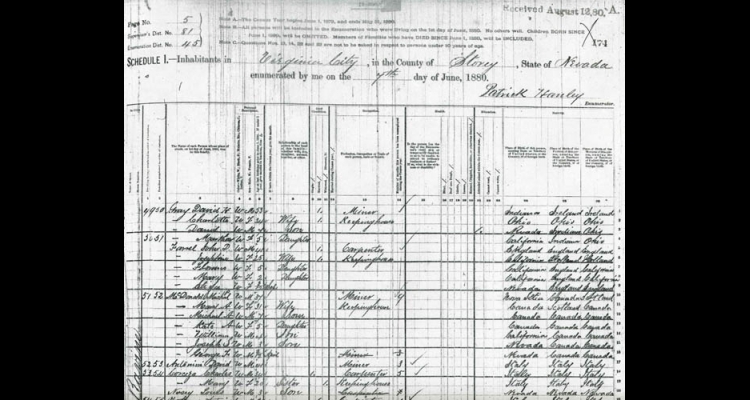Census and Demography of Nevada
The U. S. Constitution requires the federal government to conduct a census every ten years. Enumerators used hand-written pages to record information on every person in the United States. Each census employed different questions, but certain inquiries remain the same. The Census Bureau publishes reports providing general overview of the data. These documents are available at libraries that are official repositories of federal government records.
Nevada also had a territorial census completed in 1862, and a state census during the population surge in 1875 associated with the discovery of the Big Bonanza. This, together with the federal census handwritten manuscripts, represents a wealth of data useful to researchers, genealogists, or anyone interested in the history of the American West. Working with the federal material can be difficult because it involves thousands of pages of handwritten, microfilmed text. Name indexes exist, but for decades the full value of the information was elusive.
Fortunately, the Nevada State Legislature funded the nation's only example of a fully searchable database using federal census records. It is located at www.nevadaculture.org. The late Kenneth Fliess at the Anthropology Department of the University of Nevada, Reno, employed students to enter data from the federal manuscript censuses of 1860, 1870, 1880, 1900, 1910, and 1920. The 1860 census data consists of the part of the Utah Territory that would eventually become Nevada. In 1921, a warehouse fire destroyed the 1890 census, so it is unavailable.
The project did not digitize data from the Nevada territorial census or the 1875 state census because they asked too few questions to justify the expense. Simple name indexes available at libraries are sufficient for these resources.
Genealogists will immediately recognize the power of quickly searching 310,000 records to retrieve information on everyone bearing a certain last name. By browsing in the neighborhood of a specific entry, genealogists may learn of relatives, household servants, or other aspects of a family's living conditions. Those interested in understanding the past more generally will discover that it is possible to find information on diverse categories of people ranging from ethnic groups to various occupations. Community profiles or summaries of gender and age differences are available within seconds.
A study of Nevada's demographic history immediately reveals a population that varied widely over time. The nature of mining created cities where none existed, and these places were just as likely to disappear in a year or two. The state's reputation for granting sudden wealth attracted people from throughout the world, but lacking deep roots and often faced with disappointment, many left as quickly as they arrived. Because the federal census occurred only once a decade, it could not capture all the extreme variations.
Virginia City's Big Bonanza, for example, occurred in 1873, attracting thousands of additional residents. By the time of the 1880 census, many had already left. Similarly, the excitement associated with the Tonopah and Goldfield strikes occurred between the censuses of 1900 and 1910, which subsequently do not capture the extremes that occurred.
Regardless of this problem, the ease of using a fully searchable database affords researchers a unique opportunity to uncover many aspects of Nevada and western history. Thousands of insights await those who would explore this tool.
Article Locations
Related Articles
None at this time.
